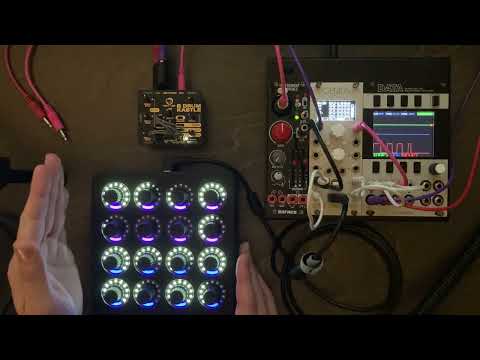Hello I’ve finished a new patch that runs on Genius and Lich (and any other OWL2 device, I imagine). It’s a feedback delay network with four stereo delays that gives direct control over the feedback matrix values (positive or negative) in addition to input level and low pass filter for each delay. It’s clockable, has a freeze mode similar to Mimeophon’s, and an internal delay time modulator for vibrato/tape warble effects. Parameter assignment will make the most sense on a MIDI controller that has knobs in a grid, like the Midi Fighter Twister.
Here’s a long, but thorough video walkthrough:
Parameter A: the length of the first delay from 2 ms to 0.25 sec, 128th to 16th note when clocked
Parameter B: the overall feedback level (i.e. attenuator on the feedback matrix)
Parameter C: the amount that the four delay times are spread out, snaps to musical durations when clocked
Parameter D: dry/wet
Parameter E: a “skew” value that offsets the left and right delay times in each stereo delay by up to 48 samples in opposite directions, which can be used to stereoize mono signals
Parameter H: an internal delay time modulator with a frequency based on the first delay duration. above 50% is a sine wave and below 50% is smooth random. the modulator waves are output to parameters F and G.
Parameters AA-AD: gain for external audio going into each delay
Parameters AE-AH: low pass filter cutoffs for each delay output
Parameters BA-BD: delay matrix sends for Delay 1: 1 → 1, 1 → 2, 1 → 3, 1 → 4
Parameters BE-BH: delay matrix sends for Delay 2: 2 → 1, 2 → 2, 2 → 3, 2 → 4
Parameters CA-CD: delay matrix sends for Delay 3: 3 → 1, 3 → 2, 3 → 3, 3 → 4
Parameters CE-CH: delay matrix sends for Delay 4: 4 → 1, 4 → 2, 4 → 3, 4 → 4
Gate In 1: clock input, will drop into unclocked mode if the clock is slower than 60 BPM
Gate In 2: toggle freeze mode
Gate Out 1: a gate pattern derived from the four delay lengths, similar to how Mimeophon gate out works. In clocked mode these will be kept in sync with the clock.
Gate Out 2: high when freeze mode is enabled
